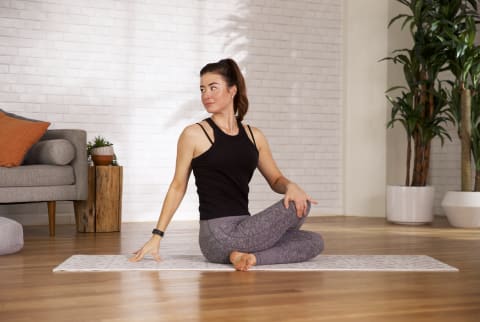Advertisement
A 12-Minute Restorative Yoga Flow For Back Pain


After a long day of working at a desk or spending hours on your feet—there's really nothing like winding down with a calming, back-supporting yoga flow.
That's why I created this gentle, restorative routine. This flow is fantastic to do if you suffer from back pain—and even if you don't, it's still a wonderful flow to open up the back, create space in the spine, and relax your whole body. In fact, I love doing this 12-minute flow right before bed, to help my body wind down, and prepare for rest.
Ready to give it a try? All you need is a yoga mat, a yoga block, and a few minutes for some blissful relief.
Summary
Equipment: Yoga block and yoga mat
Instructions: Move from one exercise to the next, following the flow cues as noted.
To start: Begin by lying on your back, and take a few deep breaths. Then bring your knees up to your chest, giving yourself a little hug. Sway side to side to massage the spine. Take a few more deep breaths, then continue to reclined twist.
Reclined Twist
- From reclined position, put your right leg over your left.
- Slowly allow your legs to fall to your left side.
- Twist your torso open to your right, placing your right arm on the ground and bringing your gaze to the side. Place your left hand on your right thigh—apply a bit of pressure if you'd like to enhance the stretch.
- Take 5 to 8 deep breaths in this position, then slowly bring your knees back to your chest.
- Repeat on the opposite side, then continue to supported bridge.
Supported Bridge
- From a reclined position, place the soles of your feet on the mat in front of you.
- Grab your yoga block, and place it below your lower back (at any height that feels comfortable). Allow your hands to rest on the ground at your sides.
- Take 5 to 8 deep breaths at your own pace. Then remove the block and place it to the side, keeping your hips lifted. Slowly lower your hips back down to the ground.
- Allow your body to rest for a few moments, then continue to seated cat-cow.
Seated Cat-Cow
- Come to a seated position, crossing your legs in front of you. Place your hands gently on your knees.
- Inhale as you round out your back; create space in your spine.
- Exhale as your release the belly and bring the chest forward.
- Repeat twice more, then continue to seated twist.
Seated Twist
- From a seated position, bring your right leg over your left.
- Bring your right arm up and over, placing your hand on the ground behind you. Place your left hand on the outside of your right thigh, to help enhance your twist.
- Take a deep breath in, and exhale as you twist to the right. Continue twisting for 5 to 8 breaths.
- Release the twist and come back to a neutral spine. Roll your shoulders a few times.
- Switch the direction of your legs, and repeat this twist on the opposite side.
- From here, move through supported bridge (see above) one more time, then continue to reclined goddess.
Reclined Goddess
- From a seated position, slowly lower down onto your back.
- Allow your knees to fall to the sides, forming a diamond shape with your legs.
- Rest here for 5 to 8 breaths, then continue to child's pose.
Child's Pose
- Slowly roll up into a seated position. Come to a kneeling position on your mat, opening up your knees into a "V" shape.
- Slowly allow your torso to fold over your legs while stretching the arms out in front of you. Allow your forehead to rest on the mat, if you'd like.
- Stay in this position for as long as you'd like to close your practice.